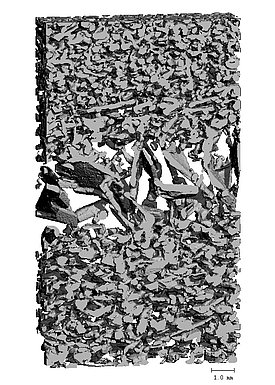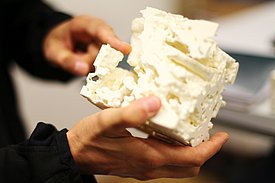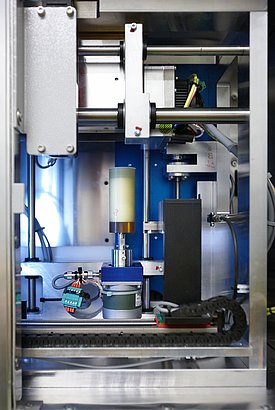
Computed tomography (CT) scanners ¶
Snow in 3D – with the aid of computed tomography in the cold laboratory, nowadays we can not only scan snow, but also reconstruct its three-dimensional structure, and even observe the changes that take place during metamorphism.
The complex ice architecture of snow is invisible to the naked eye. For this reason, in collaboration with the Swiss National Science Foundation, in 2002 the SLF became the first institute worldwide to install a micro-computed tomography (micro-CT) scanner, built by the Swiss company Scanco Medical, in a cold laboratory.
The view of snow produced by the scanner reveals the exact location of ice or air within the structure. This information allows us for the first time to depict the three-dimensional structure of the weak layers that give rise to avalanches (Fig. 1). We can also produce highly enlarged models with a 3D printer – researchers can hold the snow microstructure in their hands (Fig. 2).
Applications
Unlike the many methods that destroy the snow while measuring it, a micro-CT scanner preserves the snow’s structure. This enables us to scan a snow sample and then conduct additional tests, to determine its fracture properties, for example.
For research purposes, however, the three-dimensional tomography data are much more important as input for computer simulations. In snow physics we use such simulations to calculate the physical characteristics of snow, such as its thermal conductivity, elasticity or fracture behaviour. Another piece of equipment, the SnowBreeder, facilitates the examination in the micro-CT scanner of processes that take place within the snow structure over time, including settling and snow metamorphism.
Operating principle ¶
Expressed in simple terms, the micro-CT scanner measures the extent to which a material attenuates X-rays. For this purpose the snow sample (Fig. 3) is irradiated from the front by a micro-focus energy source, while a sensor behind the sample measures the radiation that it does not absorb. The extent of the attenuation depends on the selected energy source and the scanned material. In order to produce a three-dimensional scan, the sample is rotated and scanned up to 1,000 times per revolution. The measurement is performed in layers – after each scan, the sample is raised a little, and the next layer is then irradiated. Depending on the size of the snow sample (max. diameter 75 mm, max. height 100 mm) and the quality of the output, a complete scan can take between 4 and 24 hours.


